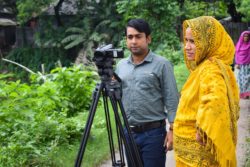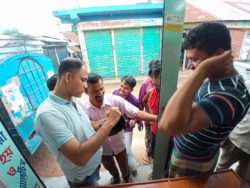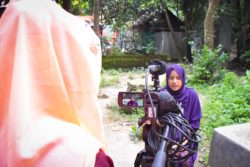Reflections on the process of PV making about AMR in Bangladesh
Written by Meahadi Islam Shuvo, Edited by Lidis Garbovan
 In a previous blog piece about Articulating PV into the CDA, colleagues from the ARK team in Bangladesh reflected on the process of conducting PV workshops with people in the community. This blog is a continuation of the reflections on the process, written by our colleague, M.I.Shuvo from the ARK Foundation, who led the workshop. The highlights of this piece are the challenges of shooting PV in rainy seasons and remote terrains and how the participants overcame these and the enthusiastic sharing of the films with local community members.
In a previous blog piece about Articulating PV into the CDA, colleagues from the ARK team in Bangladesh reflected on the process of conducting PV workshops with people in the community. This blog is a continuation of the reflections on the process, written by our colleague, M.I.Shuvo from the ARK Foundation, who led the workshop. The highlights of this piece are the challenges of shooting PV in rainy seasons and remote terrains and how the participants overcame these and the enthusiastic sharing of the films with local community members.
For the workshop on training in the art of creating participatory videos, local residents including school teachers, medical shop assistants, students, and other job holders took part. None of them had any understanding of video production or filming. Antimicrobial resistance was the subject matter of the participatory video training.
The last two days of the workshop were devoted to the participants writing their own scripts, with the trainers providing assistance and oversight. Sometimes they were divided into groups, which appeared to be particularly effective since they were able to communicate and develop innovative ideas. Notable is that the trainees were so creative that they made suggestions about how and where to place the climax, which sentence to place emphasis on, or how to grab the audience’s attention. The participants were mostly encouraged to portray realistic stories and settings. The greater the realism of the scenes, the more engaging the videos become.
Facing and overcoming challenges: rain, remote areas and realistic shooting

Following that, the process of shooting the scripts began. As the sequences were separated into numerous lengthy portions, shoots of two films were conducted in a day. Thus, approximately 8-10 hours were devoted solely to these shoots. During the course of the process, the participants were required to deal with a variety of obstacles. The first problem that they came across was selecting a location for the shooting. The majority of the shooting took place in remote areas. In addition, there was no transportation system to reach some of these remote places. On days when it rained heavily, this turmoil would only intensify. Rainfall intensity prompted the rescheduling of all outdoor activities, including filming. A number of factors, such as a cattle house, cows, a natural view, were taken into account during the filming process in order to improve the finished version. Several other complications arose during the course of filming. The participants made numerous mistakes when presenting their lines from the scripts. Consequently, it required two to three hours to film a single scene.
The production of participatory videos necessitated visits to numerous remote regions. Sometimes it was necessary to repeatedly visit their homes or other locations. Permission and availability were essential factors to consider in this circumstance. It included a pregnant woman as a participant. Her accessibility and comfort were accorded special attention. It was much appreciated that she agreed to and participated in such a program to raise awareness. Consequently, no props were required to recreate this situation. Two months after the completion of filming, this woman gave birth to a girl.
Filming and cheering together: display of skilful PV making
The participants attempted to review their own videos once they completed shooting. They grew enthusiastic and confident in their knowledge and abilities. They would sometimes bring their  relatives and friends in order to show their videos and displayed their abilities with pride. People used to gather and form a crowd in order to watch the films; hence, a festive ambience prevailed everywhere. When there was a particularly impressive scene, the crowd would break into applauding and cheering. There were times when the crowd would grow so massive that more people were needed to maintain control. The facilitators also had to actively engage in crowd control. Since the participants and trainees were so enthusiastic about the events, they provided the facilitator with a significant amount of assistance in running all the activities.
relatives and friends in order to show their videos and displayed their abilities with pride. People used to gather and form a crowd in order to watch the films; hence, a festive ambience prevailed everywhere. When there was a particularly impressive scene, the crowd would break into applauding and cheering. There were times when the crowd would grow so massive that more people were needed to maintain control. The facilitators also had to actively engage in crowd control. Since the participants and trainees were so enthusiastic about the events, they provided the facilitator with a significant amount of assistance in running all the activities.
While editing the videos, the facilitators showed them to the participants and tried to get their feedback on whether they are doing them correctly. Thus, facilitators were required to discuss with participants numerous times following the completion of the video production.
Thank you to Shuvo for sharing his reflections in this blog piece. We look forward to applying the learning from this round of PV to the next one to be conducted in 2023.
Written by Meahadi Islam Shuvo
Documentation Officer
ARK Foundation
